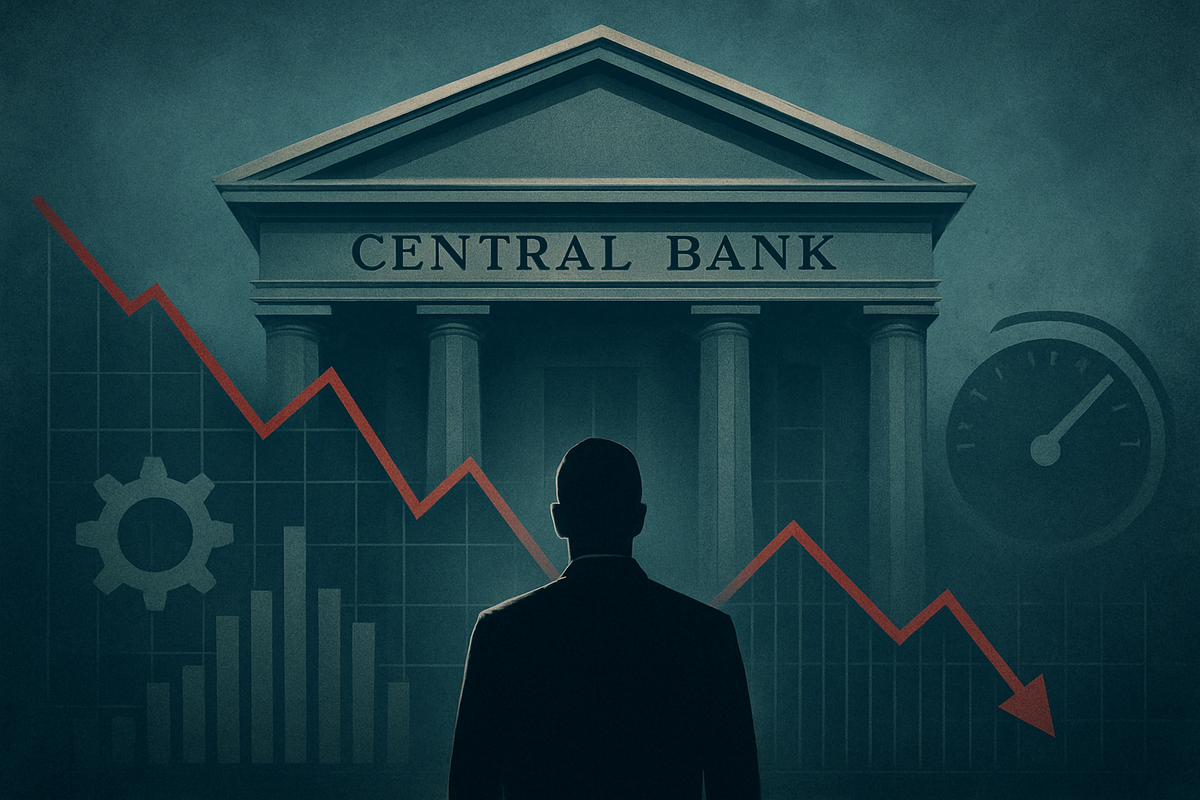
Washington D.C. – November 19, 2025 – The Federal Reserve's Open Market Committee (FOMC) meeting minutes from October 28-29, 2025, released today, have sent a clear, albeit complex, message to financial markets: while a rate cut was delivered, the path forward for monetary policy is far from certain, and the central bank's stance is more hawkish than many investors had anticipated. The revelations have immediately dampened expectations for further easing, particularly a December rate cut, leading to a notable downturn in major stock indices and a palpable shift towards caution among investors.
The detailed account of the FOMC's deliberations painted a picture of internal division and a data-dependent approach, heavily influenced by a recent government shutdown that created a "data fog." This uncertainty, coupled with Chair Jerome Powell's post-meeting remarks, has created a challenging environment for market participants attempting to price in future monetary policy, suggesting a period of heightened volatility and strategic re-evaluation for public companies and investors alike.
FOMC Minutes Unveil Policy Discord Amidst Economic Uncertainty
The minutes from the Federal Reserve's October 28-29 meeting confirmed a 25-basis point reduction in the federal funds rate, bringing the target range to 3.75%-4.00%. This marked the second rate cut of the year, alongside a decision to conclude quantitative tightening by December 1, 2025, effectively stabilizing the Fed's balance sheet. However, the seemingly straightforward policy adjustments belied a significant internal debate among FOMC members. The minutes highlighted "strongly differing views" on the appropriate trajectory for interest rates, with Governor Stephen Miran advocating for a more aggressive 50-basis point cut, while Kansas City Fed President Jeffrey Schmid argued against any change, citing persistent inflation and resilient economic momentum.
Inflation remained a key concern for the Committee, with discussions indicating that it had "moved up since earlier in the year" and remained "somewhat elevated." Some participants voiced apprehension that longer-term inflation expectations could become unanchored if inflation failed to return to the Committee's 2% objective in a timely manner. The economic outlook was characterized by moderate expansion, though job gains had slowed, and the unemployment rate had edged up. A crucial factor influencing these deliberations was a 43-day government shutdown, which severely delayed the release of vital economic data, creating an unprecedented "data fog" that complicated policymaking and heightened overall uncertainty.
The immediate market reaction to the minutes, and particularly to preceding "hawkish" statements from Chair Powell, was decidedly negative. Powell's explicit declaration that "a further reduction in the policy rate at the December meeting is not a foregone conclusion" and that "policy is not on a preset course" significantly pushed back against strong market expectations for an inevitable year-end rate cut. This guidance contributed to the S&P 500 dropping into the red, and the tech-heavy Nasdaq 100 (NASDAQ: NDX) experiencing its longest losing streak in three months, as anxieties over AI valuations and dwindling rate cut prospects weighed heavily on the sector. Investor sentiment swiftly shifted to caution, reflected in the CME FedWatch Tool showing the probability of a December rate cut plummeting from over 60% to below 35%.
Companies Brace for Impact: Winners and Losers in a Higher-for-Longer Environment
The Federal Reserve's hawkish tone and the reduced likelihood of aggressive rate cuts will inevitably create a mixed bag of fortunes across various sectors and public companies. Businesses highly sensitive to interest rates, particularly those reliant on consumer borrowing or extensive capital expenditure, are likely to face headwinds, while others may find opportunities in a more stable, albeit higher-rate, environment.
Companies that may face challenges include:
- Real Estate and Homebuilders: Companies like D.R. Horton (NYSE: DHI) and Lennar Corporation (NYSE: LEN) could see reduced demand as higher mortgage rates impact affordability for prospective homebuyers. The cost of financing new projects also increases, potentially squeezing profit margins.
- High-Growth Technology Companies: Many tech firms, especially those not yet consistently profitable, rely on readily available and cheap capital to fund expansion. A higher-for-longer rate environment makes future earnings less valuable and increases the cost of borrowing, potentially impacting valuations for companies like Snowflake (NYSE: SNOW) or even some less established AI firms that have seen significant valuation run-ups. The recent Nasdaq 100 (NASDAQ: NDX) decline underscores this vulnerability.
- Companies with High Debt Loads: Businesses across various sectors carrying substantial variable-rate debt could see their interest expenses rise, eating into profits. This includes certain industrial companies or highly leveraged consumer discretionary firms.
Conversely, some sectors and companies might stand to benefit or prove more resilient:
- Banks and Financial Institutions: A higher interest rate environment generally benefits banks like JPMorgan Chase & Co. (NYSE: JPM) and Bank of America (NYSE: BAC) as their net interest margins (NIM) tend to expand, allowing them to earn more on loans than they pay on deposits. However, this is balanced against potential increases in loan defaults if economic growth slows significantly.
- Value Stocks and Dividend Payers: In an environment where growth stocks face valuation pressure, more mature, stable companies with strong cash flows and consistent dividend payments, such as certain utilities or established consumer staples companies like Procter & Gamble (NYSE: PG) or Coca-Cola (NYSE: KO), may become more attractive to investors seeking reliable returns.
- Companies with Strong Balance Sheets and Pricing Power: Businesses that can pass on increased costs to consumers without significant loss of demand, or those with minimal debt, will be better positioned to weather a period of elevated rates and potential economic slowdown. This includes certain healthcare providers or established infrastructure companies.
The divergence of opinions within the Fed, coupled with the "data fog" from the government shutdown, means companies must remain agile, focusing on robust balance sheet management, efficient capital allocation, and a clear understanding of their interest rate sensitivity to navigate the uncertain monetary landscape ahead.
Broader Implications: A Shifting Economic Landscape
The Federal Reserve's recent minutes and the subsequent market reaction underscore a significant shift in the broader economic landscape, moving away from a predictable easing cycle towards a more cautious, data-dependent approach. This pivot has wide-ranging implications, fitting into broader industry trends of inflation persistence, recalibrated growth expectations, and the ongoing challenge of managing economic data integrity.
This event highlights the persistent challenge of inflation, which remains "somewhat elevated" despite the Fed's efforts. The central bank's concern about longer-term inflation expectations becoming unanchored suggests that even with signs of cooling, the battle against rising prices is far from over. This trend forces businesses across all sectors to continually assess their pricing strategies, supply chain resilience, and operational efficiencies to mitigate cost pressures. Industries heavily reliant on commodity prices or global supply chains will feel these ripple effects most acutely, potentially leading to continued price increases for consumers.
The "data fog" caused by the government shutdown reveals a critical vulnerability in economic policymaking and market analysis. In an increasingly data-driven world, the disruption of official statistics creates a vacuum of information, forcing policymakers to rely on incomplete pictures and investors to make decisions with heightened uncertainty. This could prompt calls for improved resilience in government data collection and dissemination processes, with potential regulatory implications for how economic indicators are reported and utilized. Historically, periods of significant economic data disruption, such as during major financial crises or natural disasters, have often led to increased market volatility and a greater reliance on alternative, private-sector data sources.
Comparing this moment to historical precedents, the current situation echoes periods where the Fed has had to navigate conflicting economic signals and manage market expectations carefully. For instance, the "taper tantrum" of 2013, when the Fed signaled a reduction in its quantitative easing program, caused significant market turmoil as investors rapidly repriced assets. While the current scenario involves rate cuts rather than hikes, the principle is similar: any deviation from market expectations regarding the pace and direction of monetary policy can trigger substantial reactions, particularly in sectors sensitive to borrowing costs and future growth prospects. The internal policy divide also harks back to periods of significant debate within the FOMC, often preceding shifts in long-term monetary strategy.
The implications extend to international markets and global trade. A higher-for-longer interest rate environment in the U.S. can strengthen the dollar, making American exports more expensive and imports cheaper. This could impact multinational corporations (NYSE: MNC) and trade balances, potentially creating challenges for emerging markets that hold dollar-denominated debt. Competitors operating in different regulatory or economic environments may find their relative cost of capital or market attractiveness shifting, leading to strategic re-evaluations across global industries.
The Road Ahead: Navigating Uncertainty and Strategic Adaptations
Looking ahead, the Federal Reserve's stance, as revealed in the recent minutes, sets the stage for a period of ongoing uncertainty and strategic adaptation across financial markets and public companies. The immediate short-term possibility is continued market volatility as investors digest the implications of a less aggressive easing cycle than previously anticipated. The diminished probability of a December rate cut means that businesses and consumers will likely contend with elevated borrowing costs for longer, impacting investment decisions and spending patterns.
In the long term, the Fed's data-dependent approach signals that future policy decisions will be highly reactive to incoming economic information, particularly as the "data fog" from the government shutdown clears. This means that upcoming inflation reports, labor market data, and GDP figures will be scrutinized with even greater intensity. Companies will need to develop more robust scenario planning, considering various outcomes for interest rates and economic growth. Strategic pivots may be required, particularly for businesses that have relied on cheap capital for aggressive expansion. This could involve a renewed focus on profitability over pure growth, optimizing operational efficiencies, and strengthening balance sheets to withstand potential economic headwinds.
Market opportunities may emerge for sectors and companies that can thrive in a higher interest rate environment or those that offer stability and strong cash flows. Value stocks and dividend-paying companies could see increased investor interest as the allure of high-growth tech stocks diminishes in a rising rate environment. Conversely, challenges will persist for highly leveraged companies and those in rate-sensitive sectors like real estate and certain areas of technology. The anxiety over AI valuations, as noted in the research, suggests that the market may become more discerning about which innovative companies truly have sustainable business models versus those relying on speculative growth.
Potential scenarios range from a "soft landing," where inflation gradually returns to target without a significant recession, to a more challenging "hard landing" if the economy falters under the weight of sustained higher rates. Another scenario involves "stagflation," where persistent inflation combines with stagnant economic growth, a particularly difficult environment for both businesses and consumers. The Fed's internal debate highlights the genuine difficulty in predicting the precise path forward, making flexibility and adaptability paramount for market participants. Companies that proactively manage their debt, maintain healthy cash reserves, and innovate to improve productivity will be best positioned to navigate these evolving conditions.
Wrap-up: A New Era of Monetary Policy Scrutiny
The recent Federal Reserve minutes mark a critical juncture for financial markets, ushering in an era of heightened scrutiny over monetary policy and its direct impact on the economy. The key takeaway is the central bank's commitment to a data-dependent, yet cautious, approach, prioritizing inflation control even if it means tempering market expectations for rapid rate cuts. The internal policy divide and the influence of external factors like the government shutdown underscore the complexities faced by policymakers in guiding the economy.
Moving forward, the market will be characterized by a greater appreciation for the nuances of Fed communication and a more realistic outlook on the pace of monetary easing. Investors should brace for continued volatility and be prepared to re-evaluate their portfolios based on evolving economic data. Companies, particularly those in rate-sensitive sectors, must prioritize financial resilience, operational efficiency, and strategic flexibility to adapt to a potentially prolonged period of elevated interest rates.
The lasting impact of this event will likely be a recalibration of investor expectations regarding the Fed's "put" – the implicit belief that the central bank will always step in to support markets. While the Fed remains committed to its dual mandate of maximum employment and price stability, these minutes suggest a more measured and less interventionist approach than some might hope. What investors should watch for in the coming months are not just the headline inflation and employment figures, but also the detailed language from Fed officials, the voting patterns within the FOMC, and any signs of shifts in long-term inflation expectations. These will be the true indicators of the market's trajectory and the broader economic health.
This content is intended for informational purposes only and is not financial advice







